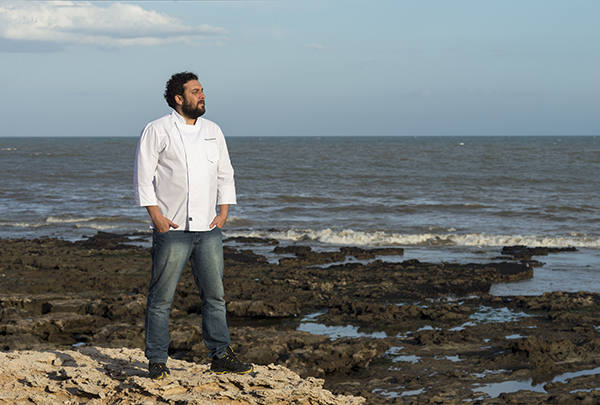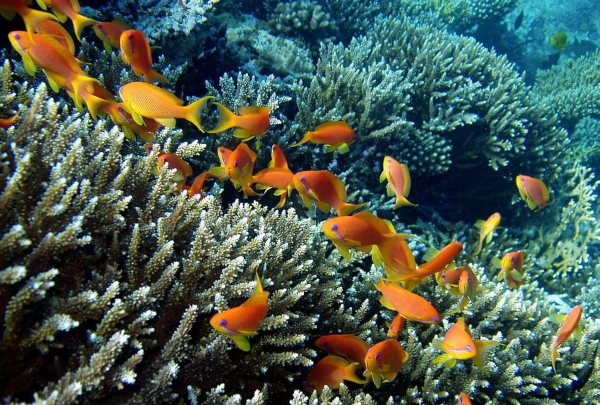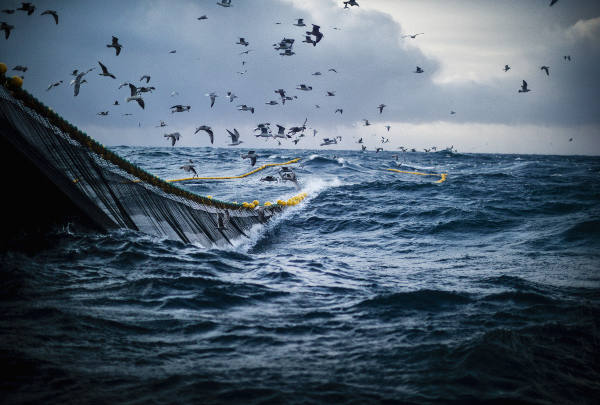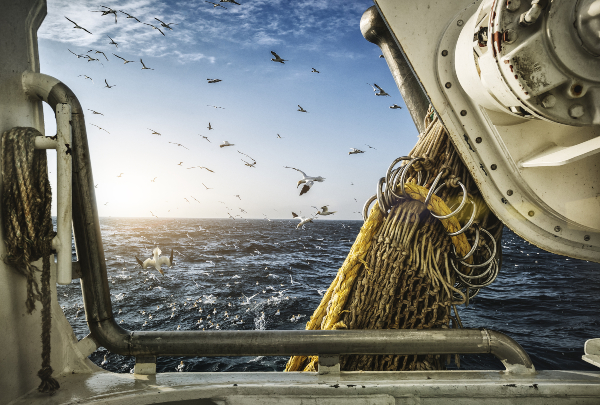Interview
Fer Rivarola: "In Argentina there is a very rich but practically ignored fish pantry"

Argentine chef Fer Rivarola, from El Baqueano restaurant -number 39 on the list of the 50 Best Restaurants in Latin America- will be one of the speakers attending the Encuentro de los Mares event. His commitment to the Argentine native product and his bond with nature and local producers have made him one of the most interesting chefs of Latin American lands. We discover his new projects.
His culinary philosophy is based on the Argentine native product. In fact, they currently work with local small producers, including collectors and fishermen from all the eco-regions of the country. It seems that this philosophy is becoming more and more common in the restaurant sector. Is this the future? Is it time for the cook to get out of his kitchen and explore his surroundings?
I was born and raised in San Cayetano, a very small town in the south of Buenos Aires province, in an environment of fishermen and country people, hunting and the sea. In my house, where the day to day was sustained by the products of the land and the Atlantic, we ate what we had and if the season was not favorable for such activity, we collected wild mushrooms, thistles, watercress? When you suck on that philosophy since you were a child, it is difficult to understand another type of work methodology on a professional level.
El Baqueano was born with that philosophy, perhaps unconsciously to emulate what was eaten at home, but travelling new paths and new searches within tradition and customs. I believe that more than the future is the present, the past in this context is also present. The future arrived a long time ago and the time has come for the cook to leave his kitchen, to listen to the ecosystem and to cook according to it, respecting the natural cycles and seasons.
They like to work with little-known products and techniques, which go beyond what the popular imagination associates with Argentinean cuisine... (they play with meats such as rhea, yacaré, llama, viscacha, buffalo, wild boar or deer and fish from the Atlantic coast such as white salmon, permit, sea bass, grouper and river fish such as pacú, fresh seafood from the San Matías gulf...)
The average Argentinean tends to think he's made it all up. If you ask him about football, barbecue and the economy, he'll tell you the country's situation in the blink of an eye. Nor do I tell you, in the cultural context associated with the act of eating, that any native of Argentina would tell you anything ¨más argentino¨ other than a pizza, an empanada and a good parrillada, a slice of sausage and Malbec wine and, for dessert, pancakes with dulce de leche. This is the first thing they could list to talk about gastronomic culture. But our habits and customs are marked by the tradition of our ancestors who came from Europe, especially from the middle of the 20th century onwards.
In the geographical triangle where I grew up there is the largest Basque settlement in Latin America and a giant community of Danish people... Imagine the mergers, imagine even a discussion...
We decided to make Argentinean cuisine, we work with Argentinean products, Argentinean producers, we live in Argentina and we are Argentinean. There is no way that our cuisine at ¨El Baqueano¨ is not Argentinean, we decided to explore other paths, and above all to use the most modern techniques we learned in Europe, applied to local products. But in that return to contemporary cuisine we rediscovered the ways of salting, of sahumar, the cauldrons, the potajes, the crudes... those traditions that in the cultural heritage and the unconscious of the Argentinean ceased to exist, but that today are a part of the contemporaneity of the post-modern cuisine.
How is that creative process from the moment you select an "exotic" product until it reaches your plate?
In principle, the creative process is marked by natural cycles. In Argentina we have 18 vast, mega biodiverse ecoregions with incredible native products, some you can use all year round and others are micro seasonal. You look at the calendar, you see that it has the Andes, the Yungas jungle, the sea, the river, to offer you, and above all, you see what you can afford! and what logistics are possible in a country of enormous dimensions. Because I might like truffles, but if I can't pay my producer, there's no point in even trying to work it.
From that point on, our dishes have to be able to tell a story. Eating a dish that does not have a common thread makes no sense, at least in El Baqueano, that does not have a socio-environmental history behind it, or an added value, a designation of origin or a geographical indication in haute cuisine, is pure hedonism. And I am not saying that it is wrong, just that it is not the path we want to take.
This is how dishes like the false octopus bacon como¨Homenaje to the invisible octopus of Bahia camarones¨ (enteroctopus galocyathum) incredible octopus that is born in our coasts but that is practically impossible to obtain because some unscrupulous "¨empresarios" locals take it. Or, for example, the dish called Fossil of anchovies, a butter of anchovy, which tells the sad story of this beautiful pelagic (engraulisanchoíta) threatened by the ¨sub explotación¨ (if you read correctly, we have an under-exploited product that ends up in very low quality salted fish, exported in semi-smuggled form to Europe, perhaps many of which you can buy in Mercadona or El Corte Inglés are from these places).
Or the marine alfajor, the first salted alfajor in Argentina that pays homage to the sea and its people, made entirely of Patagonian prawns (pleoticus muelleri), covered with garlic sauce and filled with seafood casserole. In this way, each dish comes to life and dresses up the tasting menu of El Baqueano.
Do you think that this way of working has contributed to turning gastronomy into a social tool? Is this what Milpa, the project you have been working on in the last few months, emphasizes?
In principle, there is a Latin American current that has three points of spearhead: Alex Atala, in Brazil, who has been working on gastronomy as a social tool for years; Enrique Olvera, in Mexico, with the vindication of Mexican cuisine as an intangible heritage of humanity, and Gastón Acurio, and the social revolution as a gastronomic weapon.
Each one of them has contributed in a giant way so that our generations of cooks are inspired to be much more than mere consumer gastronomy. Milpa, on the other hand, is an incredible Mesoamerican ancestral farming system, which I got to know thanks to my friend and great Mexican chef Jorge Córcega, who has been working at ¨Ruta of Milpa¨ for years in San Pedro Atocpan, the town hall of Milpa Alta, where they celebrate the national mole fair in the rural area of the CDMX.
I was fascinated by what is achieved there in terms of product and consumption, respect and work with the native blue and red corn, nopales, pumpkins, beans. We thought it would be nice to pay tribute to something that is associated with the land and the producer, which has been the food of thousands of families since time immemorial. I recommend a lot to understand this process that you watch the documentary ¨El corn in times of guerra¨. We had already been working on the problems of our small producers for some time, so much so that two years ago we presented the documentary ¨El Baqueano - Stories of the Invisible Argentina -" at the Malaga film festival, a small sample of the work and suffering of the cooperatives of producers in the high Andes with whom we have been in contact for a long time. The idea in this context of pandemic was to create a virtual market of producers with socio-environmental awareness. Those products that have an added value and benefit the communities of producers who are most disadvantaged and invisible by current consumption systems.
What is this about? Information, dissemination, fair trade, direct purchase (without intermediaries) and spectacular products from our country, such as melipona bee honey, carob flour, native fruit vinegars, spices and condiments from the Calchaqui valleys, Andean papines from the cooperatives in the Quebrada del Toro, the organic quinoa from Santa Rosa de los Pastos Grandes, among others, to name a few.
When you talk about your restaurant El Baqueano, what do you mean by "sustainability"?
Sustainability, this word so in vogue, that we hear more and more every day, is environmental awareness, agricultural development, nutrition and biodiversity conservation, food production, and above all food sovereignty, in a word, being friendly with the conservation of our ecosystems and biomes, for future generations.
How is it applied or should it be applied in restaurants, respecting the hunting, fishing and gathering seasons, working with non-traditional meat breeders, getting closer to the small fisherman and gatherer/grower, but above all paying them. It is no longer good for producers to take a picture of you to get on their instagram, it is not cool, let alone sustainable.
It is also important that you know and can work with compostable and biodegradable materials, so your country or your government should have policies for recycling disposable and organic materials. Because it may be nice to say, but someone has to apply a treatment to the garbage we recycle. We can't put all the responsibility on the cooks. It is a huge job, and infinite work that must be done between people of different kinds.
For some time now we have been studying and trying to work out how to eliminate, for example, film paper from our kitchens, and replace it with recyclable fabrics, worked with tree resins and beeswax for use as covers. Or also in the study of the use of waste and its reuse with different natural polymers for the manufacture of possible kitchen utensils. Today there is a giant pro-activism in this respect. Without going any further, our new project Trashumante -the new restaurant that has just opened-, uses 90% of compostable materials that in 180 days are transformed into soil, for the packaging of their informal rations deliveries.
How has the covid-19 effect been experienced in Argentine restaurants?
Unfortunately, we have experienced the effects of COVID-19 in a tragic way in the restaurant industry. Thousands of shops related to the gastronomic sector have definitively lowered their blinds and the trend indicates that nobody knows who or who will survive.
At present, we barely have more or less informal protocols to work with food deliveries, which is the only thing that is allowed at the moment (we have had to return to phase 1 due to the bad policies applied during the 100 days of confinement that we have had). Unfortunately this is not a sprint race, it is a marathon where the person who has the most oxygen will win.
In Spain, some chefs have taken advantage of the confinement to reformulate their businesses and activate new projects. You have just opened the restaurant Trashumante. Tell us about this project. How does it differ from El Baqueano?
Trashumante is El Baqueano's younger brother. They are informal frozen rations, raw or pre-cooked to regenerate at home. It was born in this context of pandemics and forced confinement due to the current situation but it is an idea that had been in the making for a long time. We always had the fantasy of being close to the local public through a slightly more massive and popular product.
When we founded El Baqueano, the local public, in spite of working with local products, stuck us inside ¨las rarezas¨ of Buenos Aires, so it was very difficult to promote our work. The fantasy began years ago to take shape in informal dishes through local fairs such as ¨Masticar¨ with the choripán de pacú (a river fish that thanks to sustainable breeding can be eaten today), the yacaré empanada (a farmed caiman that recovered from the pressure of man's hunting thanks to the ranching technique), the mbejú buffalo taco, the torreznos in the agripante style, and so on and so forth until in 2018 we were invited to participate in a contest at the Copenhagen food fair, Top Dog Charity, to raise money for the Massimo Bottura Food for Soul foundation and we traveled with 100 kg of food and our mother chimichurri lamb barbecue sausage and won the contest, and ironically we became famous for a hot dog -he laughs-
Trashumante summarizes all that and a couple of points that are a plus, sustainability through fair trade with the producers who provide us, packaging (not only biodegradable) but in a 90% compostable and not using delivery platforms, since we make our own deliveries to ensure quality.
Do you think that this pandemic has made us more aware of the link between restaurants and nature?
I wish it had. I hope that, as the saying goes, coming out of this pandemic and then out of this social and economic crisis, will find us better. I think that in restoration what needs to be finished is with the posture and with the work for the camera and for the prize, as long as we continue on this wrong path it is going to be difficult for us to be more aware of how to return to a natural environment. Especially since most restaurants are located in the great capitals of the world.
What will be the contribution of El Baqueano in Encuentro de los Mares?
For a restaurant as small as ours, it is a great honour to be considered for events of this magnitude, so we are preparing a presentation where we will show, true to our philosophy, a little of the difficulties suffered by our seafarers, as well as the work we are doing at El Baqueano, in order to put on a tasting menu seafood dishes in a society accustomed to consuming beef.
The importance of the health of our seas and the environmental impact on them is increasingly present. What is the situation of the marine environment that you know? Are you involved in any related project?
The Atlantic Ocean is vast and as such suffers the consequences almost as much as many of the planet's marine ecosystems. We have many problems with the illegal fishing by Asian and European ships at mile 201 of the continental shelf, also with the fight to implement legislation that regulates zero discards in factory ships, the fight for the non-installation of pink salmon farms in the Beagle Channel. In addition, there is the precariousness of the fishing industry and the lack of consumption in the domestic market.
There is a lot of work to be done. In particular, we work closely with people who provide us with information within the INIDEP (National Institute of Fisheries Research and Development) about activities and studies that are advancing on sea products, although I recognize that there is a lack of joint work between gastronomy and the scientific field and in terms of incorporating the measures of the Ministry of Agriculture, Ganadería y Pesca, together with the table promoting the consumption of fish and seafood, established the campaign ¨Pescados and Mariscos Argentino, sabores que te hacen bien", under the slogan "on the 19th of every month we eat fish with the aim of giving value to the national aquaculture production and increasing consumption in our territory".
During the last year, through the direct work in the commercialization of varied seafood with artisan fishermen from Mar del Plata, Necochea and Quequén, we started a study to improve the catches with line fishing, the sacrifice, the conservation of the fish and the use of the different muscular groups, as well as the use of viscera, which is not usual in our gastronomic culture.
In addition to the native meats, the main axis in their menu in the beginnings of the restaurant, they have been incorporating other products like the native fish. Possibly, the great unknown of the Argentinean cuisine, at least within our perception in Spain. Which are the most outstanding autochthonous species? Where does this interest in the sea come from?
I always say that one day I will end up by the sea where I grew up, where I fished as a child with my father, but I will do it by working with sea products that I love, and above all, by trying to bring people closer to these incredible products and to learn together ways of consuming them and incorporating them into our diet.
I believe that if one day we realize that one of the healthiest sources of protein that we can consume and in a completely wild state comes from our sea, we will drastically change our way of understanding how to feed ourselves and above all how to understand the sea.
When we began to include the meat of river fish in the menu of non-traditional meats at first, and then those of the sea, some customers questioned us because we put them on the menu. "But fish is not meat", they said -she laugh- as if it had to have four legs to be meat.
There is so much misinformation that, besides the State, we are all a little responsible.
In Argentina, you put on TV for a while and on the cooking programs the fish they prepare most is pink salmon (which, by the way, isn't even Argentine!).
We have a delicious pantry but it's practically ignored by everyone. Being ignorant is not a sin, but refusing to learn and change habits is. Last year we were invited to the Basque Culinary, showing a magnificent work, with a protected species of our rivers, first cousin of the Amazonian gamitana, the pacú, (piaractus mesopotamicus) or river pig, a great unknown for many but that, However, it has generated enormous satisfaction for us and some spectacular dishes such as the ¨falso steak from chorizo¨, the cold-smoked ribs with marine barbecue sauce, the river ham, the choripan, the chicharrones de su piel and many others. So we have travelled from the river to the sea, until we made beautiful works with the pollock (pink in Spain); lemon fish, one of the great vedettes of the Argentinean sea; the anchovy, the pejerrey, the chernia, the anchovy of bank, the hake of palangre... there are approximately 30 varieties available in the course of the year and there are others that are obsessions for me like the fuegian sardine that have no commercial value and that makes them inaccessible for the local consumer.
In Spain, the chef Ángel León studies and investigates the Andalusian sea bed to turn it into the garden of his restaurant. Would it be viable in Argentina? Is there a similar project?
I was lucky enough to meet Ángel León personally at a gastronomic congress in Chile in 2013 and just a couple of years ago, I had the enormous joy of sitting down to try his tasting menu in Aponiente and live out one of my greatest dreams. I was fascinated by his work.
When I lived in Andalusia back in 2001, the gastronomic vanguard in that area was practically unthinkable. The sea was pure product ¨sin virguerías¨, you would arrive at a kitchen and the chef would ask you, almost with derision, "and who do you like? Ferran Adrià or Santi Santamaría", as if the contemporaneity and the use of the product did not go hand in hand. It was a Boca/River but from the gastronomy. It was good and evil, as if the two could not live together. Heaven and hell.
I think we still have a lot to learn. Personally, I always like to work from an academic/scientific side, I am very curious, I read a lot, I travel, I do research, and fortunately in our country we have very advanced research and development centers, such as CONICET, CENPAT, INTA, INIDEP, we always have a researcher friend who collaborates in our doubts and curiosities. I recognize that there is still much more to do for the gastronomic and scientific fields to work back to back in order to reach the public more quickly and above all in what concerns the Atlantic Sea.
Finally, some years ago you launched the project Cocina Sin Fronteras. Could you tell us about it?
I am very proud to talk about Cocina SIN Fronteras because it is perhaps the most ambitious project we are carrying out at El Baqueano. In 2011 we are invited to Brazil to a congress to talk about our work, and we thought that we were only cooking. Imagine. There we met countless incredible cooks and researchers like Harold McGee, or Alex Atala who two years later would be the godfather of our project.
We were always concerned about what was going on in LATAM, at a time when in Argentina we had neither gastronomy congresses nor even cooks' associations to represent us, nor was it usual to have 4-handed dinners.
So in 2013 the idea arose to generate a synergy between cooks from all over Latin America (and of course the world), and show that geopolitical borders do not exist, that the biome cares about three cucumbers where you plant a flag. And the truth is that it went very well, more than 50 chefs from all countries, including Argentina, collaborated in the kitchens of El Baqueano, and we in theirs. We were in at least 15 different countries, and we are proud to have cooked with such renowned chefs as Alex Atala, Andoni Luis Aduriz, Mitsuharu Tsumura, Daniel Burns, Kamilla Seidler, Paco Morales, Virgilio Martínez, Luis Alberto Lera, Gastón Acurio, Rodrigo Oliveira, Pedro Miguel Schiaffino, Mikel Alonso, Carlos García, Matías Perdomo, Jorge Vallejo, among many others. I believe that somehow we open the doors for people from all latitudes to dare to show their kitchens and their work, because you have to be brave, when you invite people to your house, you show your virtues, but also your defects. We missed the book, but that's another matter.







